India’s Dazzling Destination Dining

Passionate and visionary chefs are blending tradition, innovation, and local flavors with global standards to create restaurants with stunning architecture, ambiance, and menus that would leave even the most demanding epicureans smiling.
Thanks to rising incomes, urbanization, and the world’s largest youth population, which is itching for world class experiences, India's fine dining scene is on a spirited surge. Glamorous restaurants with stunning decor and equally inspired menus are cropping up all over the metros, and some even in rural settings.
Interestingly, while the vibes and quality may be globally competitive, the culinary heart of these establishments beats with the flavors and ingredients sourced from India's diverse towns and hinterlands, marked by a renewed focus on regional cuisines. Moving beyond generic pan-Indian menus, visionary chefs are vying for discerning diners by diving deep into the culinary heritage of specific states. In their quest for crafting menus rooted in place and tradition, they are resurrecting forgotten recipes, using rare and often overlooked ingredients, and championing local producers.
Across the nation, chefs are embarking on immersive journeys into remote villages, towns, and farflung regions, to better understand their culinary roots. Their invaluable discoveries are then translated into innovative dining experiences that are authentically grounded yet remarkably inventive. All this action happens in restaurants that could be pulled straight from the pages of a luxury design magazine.
This movement is about more than just food; it’s about storytelling, community, and preserving cultural identity through dishes that reflect India’s extraordinary diversity. From Telangana’s millet-driven cuisine and Goa’s tribal influences to Himachal’s Himalayan flavors and Maharashtra’s forest-inspired fare, a new generation of restaurants is redefining Indian gastronomy by embracing the regional and the rare.
Indian Accent, Delhi and Mumbai
This veritable institution—one that set the benchmark for progressive, modern luxury Indian dining—was once led by Chef Manish Mehrotra, who helmed the restaurant for over a decade and propelled it to international acclaim. This trend-setting restaurant remains deeply rooted in Mehrotra’s culinary philosophy: reimagining classical Indian food and ingredients through inventive techniques and global influences. Consistently ranked among Asia’s 50 Best Restaurants, it is celebrated for its trailblazing approach to Indian flavors.
Chef Mehrotra drew on his childhood memories and travels across India to craft a diverse palette of regional flavors, merging nostalgia with sophistication. Today, Chef Shantanu Mehrotra, the restaurant’s backbone since inception and Chef Manish’s trusted right hand for decades, leads the kitchen. He brings a distinct perspective, refined technique, and an intimate understanding of Indian Accent’s ethos. “We pick the most traditional elements—the most basic techniques, dishes, and ingredients—and elevate them on a global platform,” he proudly proclaims.
Chef Shantanu believes that uniqueness—born of a chef’s creativity and culinary knowledge—is what sets a restaurant apart. Each dish is crafted with intention, often rooted in personal memory or cultural heritage.
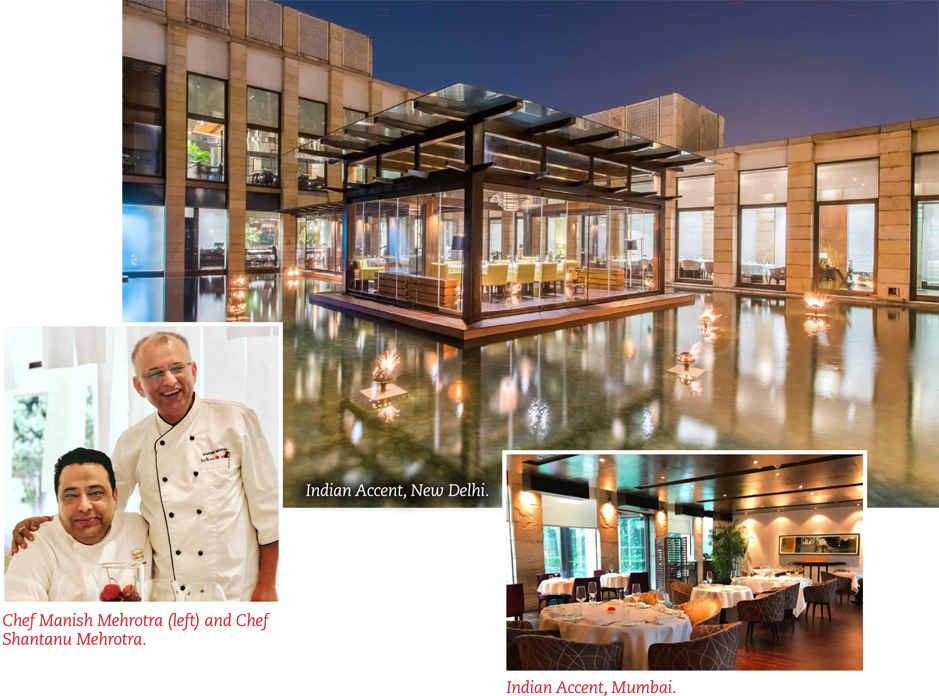
Menu: Tasting menus are Indian Accent’s signature: six- or seven-course experiences that highlight seasonal ingredients and inventive flavor pairings. Standout creations include Black Carrot Halwa Cannoli, a traditional Indian sweet transformed into an Italian avatar; Kadhai Paneer, a familiar classic reimagined with contemporary flair; Daulat ki Chaat, a cloud-like North Indian dessert, elevated through modern technique; and Meetha Achaar Pork Ribs, a fusion of sweet Indian pickle with globally inspired pork ribs.
When Indian Accent first opened, Chef Manish broke the mold by excluding trite dishes like Butter Chicken, and instead spotlighting lesser-known preparations. This bold approach gave rise to daring combinations like Warm Doda Barfi Treacle Tart and Blue Cheese Naan, blending international ingredients with Indian sensibilities.

Bawri, Goa and Mumbai
In the village of Assagao in north Goa, which is home to luxury villas across winding roads, as well as in the hustle-bustle of the corporate enclave of Bandra Kurla Complex, Mumbai, Bawri is quietly redefining Indian fine dining by going back to its roots to revive the forgotten soul of Indian cuisine. Hence, favorite classics like butter chicken and a quintessential Punjabi breakfast of poori bhaji, chhole kulche, and stuffed parantha are its popular offerings.
Chef Amninder Sandhu’s journey began early, at 17, when she joined the Taj Hotel’s Masala Bay in Mumbai. But she came into prominence as head chef at Arth, Mumbai, India’s first gasless kitchen, where she cooked on sigris (stoves powered by coal or wood). It is this personal and collective heritage that Chef Sandhu brings into the kitchen at Bawri. She tends towards traditional cooking techniques and tools such as sil-batta and copper pots. Her approach is deeply personal, drawing on her Punjabi roots and an upbringing in Assam to create food that evokes memory as much as it celebrates craft.
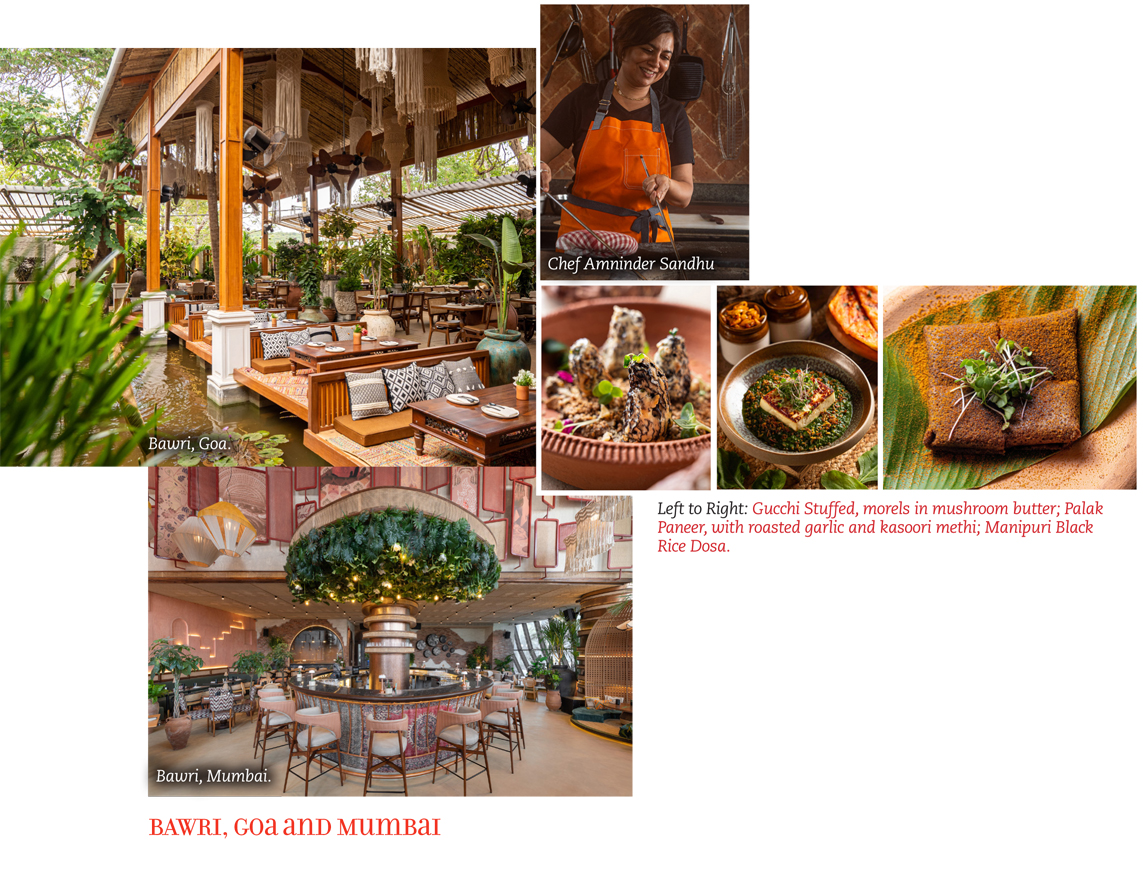
Her partner in Bawri is Sahil Sambhi, a restaurateur known for concepts like VietNom and The Drunken Botanist. Sambhi brought structure to Sandhu’s fire, managing operations and strategy. He envisioned Bawri as a grandmother’s home reborn: nostalgic, warm, and a little whimsical. “Goa, with its diverse, relaxed diners, was the perfect setting for this kind of slow, soulful dining,” he says.
At Bawri, the kitchen isn’t hidden—it’s part of the show. Tandoors, sigdis, and a Josper grill glow visibly, infusing the air with smoke and spice. You see the work; you hear the sizzle. It’s a dramatic stage for slow cooking. The space itself—9,500 square feet—is designed like a tropical Indian cottage. The open-air layout weaves through koi ponds, floating cabanas, and low charpai seating, beneath a canopy of palms and frangipani.
Menu: Each dish at Bawri tells a story. The Jungli Murgi, a hay-smoked chicken in earthen pots, recalls rustic kitchens in northeast India. The Naga Crispy Pork Salad is a nod to pomelo trees from Chef Sandhu’s childhood garden. The Bawri menu isn’t organized by region or course. It’s curated like a memory book. Every plate is deliberate and deeply rooted: from Gucchi Stuffed, morels in mushroom butter, to Pathar ka Gosht cooked on granite slabs. Dishes like Butter Chicken, with gravy cooked for six hours, and Raan Biryani, slow-cooked to tenderness, are less about novelty and more about technique.
Sustainable sourcing is non-negotiable: Manipuri black rice, Coorg’s kachampuli, Khapli atta from Pune, and antibiotic-free poultry. The oils are coldpressed and the ghee made from grass-fed cow’s milk. Goan ingredients like Gota mangoes, Chonak fish, and Feni, the distilled alcoholic beverage typically made from fermented cashews, root the restaurant in its geography.
Bombay Canteen, Mumbai
The Bombay Canteen was the late Chef Floyd Cardoz’s dream—a tribute to the food of his hometown, Mumbai, which he deeply missed while working in New York. He partnered with Sameer Seth and Yash Bhanage, and brought on board a spunky young chef, Thomas Zacharias, who remained a key creative force until 2020.
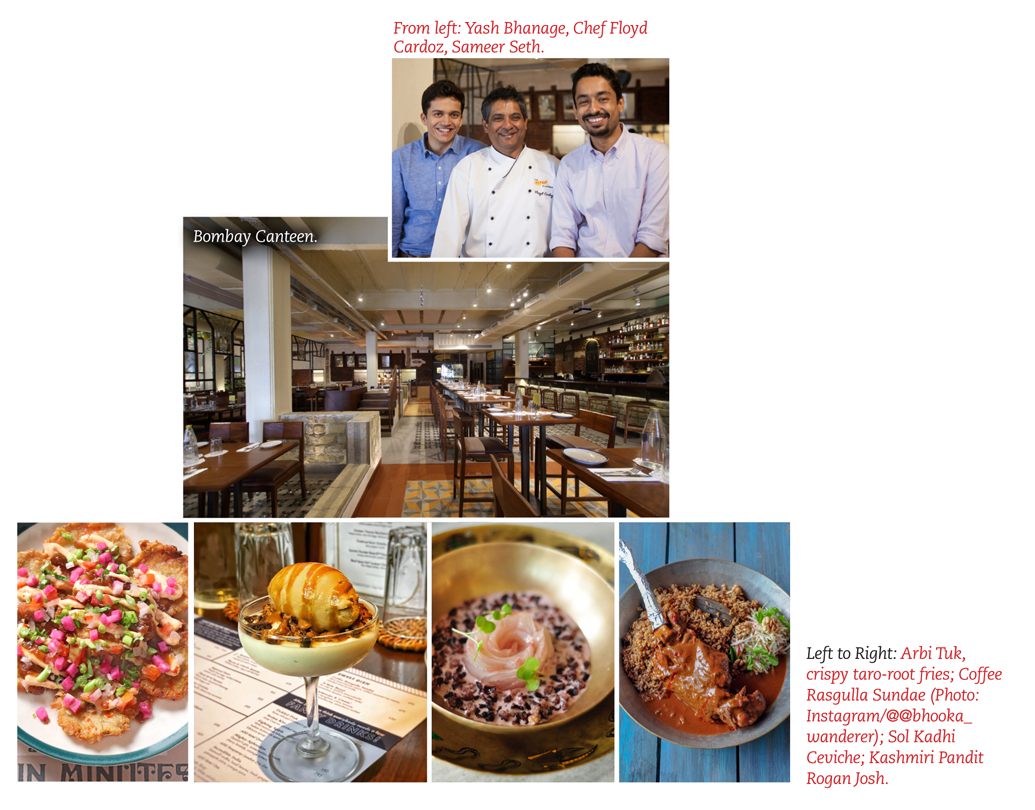
Seth, a former banker and IIM Kozhikode graduate, and Bhanage, an IHM Goa alumnus, met at Cornell University’s School of Hotel Administration. Inspired by a global wave of chefs returning to their culinary roots, they saw a void in India’s fine-dining landscape, which remained largely Westernized or overly stylized. Their vision aligned perfectly with Cardoz—acclaimed for his work at Tabla and Bombay Bread Bar in New York City—who brought with him a locavore philosophy rooted in his Goan-Mumbai upbringing. Together, the trio envisioned a space where forgotten ingredients, age-old recipes, and seasonal Indian produce would take center stage.
Since 2020, Chef Hussain Shahzad—a Welcomgroup Graduate School of Hotel Administration alumnus with experience at Eleven Madison Park—has led the kitchen at The Bombay Canteen. “The Bombay Canteen’s core philosophy is to celebrate India’s regional cuisines without borders, showcasing underrepresented dishes and hyper-local ingredients.
It's menus shift three to four times a year, aligned with India’s seasons and harvest cycles. Whether it’s monsoon bhutta, summer mangoes, or winter kokum, the produce drives the innovation,” says restaurateur Yash Bhanage.
Despite the tragic loss of Chef Cardoz in March 2020 and the departure of Chef Zacharias, The Bombay Canteen remains a cornerstone of modern Indian dining. It has received numerous accolades, including Best Indian Restaurant at the 2024 World Culinary Awards.
Menu: Staying true to its philosophy, the kitchen uses ingredients sourced within a 150-mile radius whenever possible. Traditional recipes are transformed with modern techniques, evoking nostalgia while delivering unexpected twists. The restaurant is known for its playful-yet-grounded reinterpretations of Indian classics. Signature dishes include Chilled Sea Bass Sev Puri, a sophisticated take on Mumbai street food, featuring cured sea bass, raw mango, nimbu chunda, pickled Bhavnagri chilies, and sev atop a crispy fried chapatti; Coffee Rasgulla Sundae, an Indian take on tiramisu made with coffee-soaked rasgullas, rum-mascarpone cream, salted caramel ice cream, and almond brittle; Arbi Tuk or crispy taro root fries served with contemporary dips, inspired by regional Indian snacks; Pork Birria Taco, a playful fusion of Maharashtrian and Mexican flavors; and Smoked Pumpkin Launji, a winter special featuring charred pumpkin, tangy launji (a sweet and tangy relish), and roasted sorghum (ponk).
“The menu reflects the length and breadth of India, from Chettinad prawns to Punjab-style matar paneer with a twist,” says Chef Shahzad, who, along with the TBC team, also runs three other celebrated dining establishments: O Pedro’s, a Goan restaurant; Veronica’s, a new-age sandwich shop; and Papa’s, a 12-seater restaurant dedicated to the late chef Floyd Cardoz, for which bookings open only once a month, for an hour. “Our philosophy of food and cooking will always be the same—a huge commitment to seasonal and local ingredients and techniques, not taking ourselves too seriously, genuinely having fun in the kitchen, and highlighting the diversity of Indian food in a way that brings joy to the table.”
Naar, Kasauli, Himachal Pradesh
In the serene hills of Kasauli, Himachal Pradesh, Chef Prateek Sadhu’s destination restaurant offers a Himalaya-centric menu that redefines destination dining. After establishing his reputation with the trailblazing Masque in Mumbai, Chef Sadhu embarked on a new culinary journey, partnering with Deepak Gupta, founder of the sustainable retreat, Amaya. Nestled within villas designed by Bijoy Jain of Studio Mumbai, Naar—meaning "fire" in Kashmiri— is a 16-seater restaurant with a dedicated food lab for experimentation.
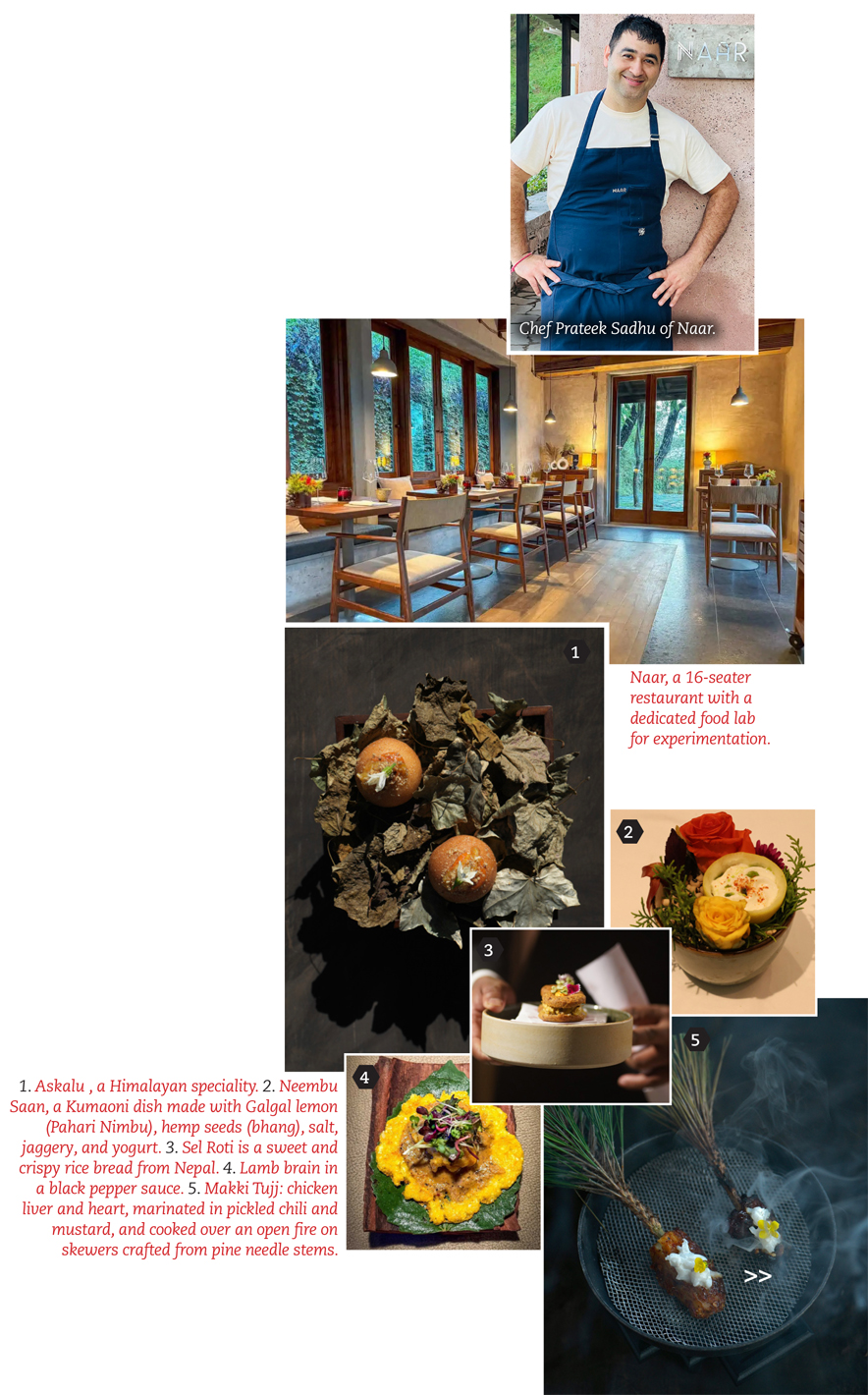 Blending traditional Himalayan ingredients and recipes with contemporary techniques, Sadhu creates dishes that challenge conventional notions of fine dining. He calls the food “micro-regional,” rooted deeply in the diverse culinary landscape of the Himalayan belt. Located two hours from Chandigarh, Naar is an invitation to experience fine dining as an immersive, destination-led experience.
Blending traditional Himalayan ingredients and recipes with contemporary techniques, Sadhu creates dishes that challenge conventional notions of fine dining. He calls the food “micro-regional,” rooted deeply in the diverse culinary landscape of the Himalayan belt. Located two hours from Chandigarh, Naar is an invitation to experience fine dining as an immersive, destination-led experience.
“My inspiration for Naar stems from my deep connection to the Himalayan region, particularly my childhood in Jammu and Kashmir,” says Sadhu. His journey at Masque, where he championed Indian regional cuisine, intensified his desire to focus on the underrepresented flavors of the Himalayas. And so, at the height of his career, he stepped away to reclaim his roots through this project.
“I spent nearly two years traveling across the Himalayan belt—from Ladakh to Arunachal Pradesh—researching ingredients, techniques, and culinary traditions. I documented ingredients like wild greens, and native grains, as well as fermentation techniques. This journey shaped Naar’s ethos of celebrating the region’s biodiversity and cultural heritage.” Working directly with local farmers, foragers, and artisans, Sadhu embraces a farm-to-table philosophy rooted in sustainability, local economic support, and culinary preservation.
An appointment-only restaurant with just 20 covers, Naar offers a multi-sensory experience that combines food with storytelling, art, and music. Designed by Studio Organon, the dining room showcases local craftsmanship, handwoven textiles, and wooden elements that evoke the spirit of the Himalayas.
Naar’s innovative approach to a cuisine few Indians truly know has earned it international acclaim, including a spot on Condé Nast Traveler’s Hot List 2024 and Gault&Millau’s Best New Restaurant 2024.
Menu: Naar’s menu features seasonal ingredients from across the Himalayan region—smoked pork, wild mushrooms, stinging nettles, fermented bamboo shoots, and more. The evolving seven-course tasting menu takes diners on a culinary journey through the mountains. “Each course highlights a specific ingredient or technique, such as foraged greens or smoked meats, paired with storytelling about its cultural significance.”
A plate might feature yak cheese from Sikkim orbuckwheat from Himachal, accompanied by a narrative of its origin. Signature dishes include the Yak Cheese Cigar; Shabdeg, an offering of Kashmiri rice with smoked lamb neck and egg yolk; Sunderkala, a noodle dish from Uttarakhand’s high altitudes; and Pine, Pine, Pine, a dessert inspired by pine-scented valleys.
The bar complements this philosophy with drinks made from local ingredients, such as rhododendron wine and teas from Darjeeling estates. “The pairings are designed to complement the menu’s flavors and enhance the regional focus,” Sadhu explains.
By foraging ingredients and reviving regional recipes, Sadhu subverts the conventions of fine dining. “Running a restaurant like this is any chef’s dream. You forage across the Himalayan region for the ingredients, you pluck things and cook with it.”
Masque, Mumbai
Masque’s signature attraction is a meticulously crafted 15-course tasting menu served in a strikingly restored Mumbai textile mill. Under the leadership of self-taught cook and hospitality entrepreneurs Aditi Dugar and Head Chef Varun Totlani, Masque has garnered numerous accolades since opening in 2016—from the One To Watch Award in 2020 to a spot on Asia’s 50 Best Restaurants list in 2021, as well as the title of Best Restaurant in India for three consecutive years.
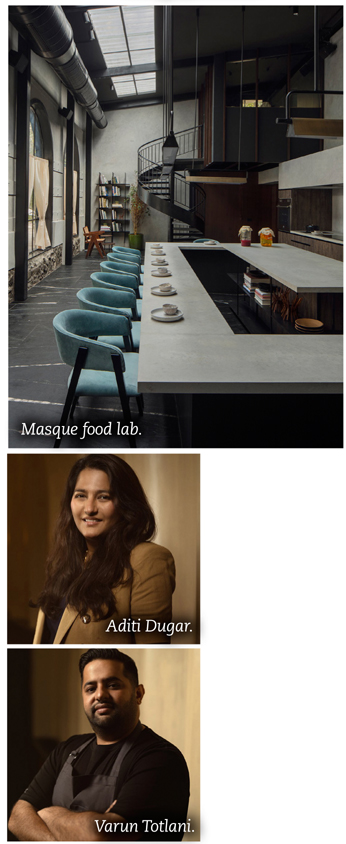
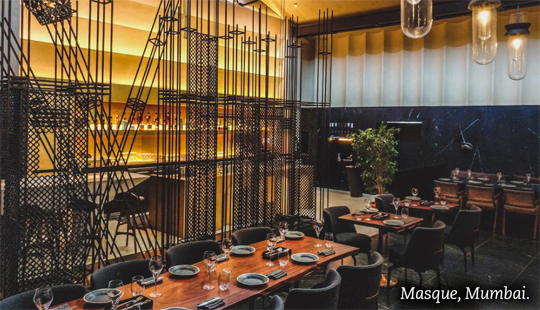 Though Aditi has no formal culinary training, her passion for food and hospitality led her to develop Masque as a platform for modern Indian cuisine. She was named Restaurateur of the Year by Food & Wine magazine’s Tastemakers Awards in 2023 and included in Elite Magazine’s list of Asia’s Most Influential People in the same year.
Though Aditi has no formal culinary training, her passion for food and hospitality led her to develop Masque as a platform for modern Indian cuisine. She was named Restaurateur of the Year by Food & Wine magazine’s Tastemakers Awards in 2023 and included in Elite Magazine’s list of Asia’s Most Influential People in the same year.
Dugar was inspired by international fine-dining experiences that revealed Indian cuisine’s untapped potential beyond clichés like curry and naan. “The idea was to present Indian ingredients through a refined, tasting-menu-only format—a bold concept in India at the time.”
Mumbai-born Chef Varun Totlani joined Masque in 2017 as Chef de Cuisine under former Head Chef Prateek Sadhu (who now runs Naar), rising to Head Chef in 2021. He has trained in globally renowned kitcens—including Heston Blumenthal’s The Fat Duck in the U.K. and Gaggan in Bangkok.
“My menus spotlight lesser-known ingredients— such as Himachali pinecones, fermented bamboo shoots from Nagaland, and fiddlehead ferns from Uttarakhand— bringing indigenous elements to fine-dining in compelling, modern formats,” says Totlani. Drawing on his experiences at The Fat Duck and Gaggan, he incorporates avant-garde techniques such as spherification and fermentation into dishes rooted in Indian flavors. His culinary worldview is shaped by the farmers and foragers he meets, and the ingredients he uncovers during his travels.

Menu: At Masque, dining is a narrative-driven journey through India’s rich and diverse culinary landscape. Each course of its plentiful tasting menu is shaped by the ingredients themselves—vibrant red amaranth from Pune, briny seaweed from Tamil Nadu, and stinging nettles from Uttarakhand. The menu is a living, evolving showcase of the country’s biodiversity.
Seasonality plays a defining role. In summer, diners might encounter the bright, juicy notes of mangoes or the delicate sweetness of coastal crab. In winter, the focus shifts to earthy root vegetables and hardy Himalayan herbs. Dishes like a corn husk soup—blending smoky, charred husks with fresh-foraged greens—or a plate of fiddlehead ferns and morels from Kashmir champion underrepresented biodiversity. Even Masque’s bar reflects this ethos. Cocktails lean into hyperlocal botanicals like kokum and gondhoraj lime. Fermented rice water, smoked Himalayan pine, and zero-proof pairings with complex flavor profiles mirror the inventiveness of the kitchen, delivering a full-circle sensory experience.
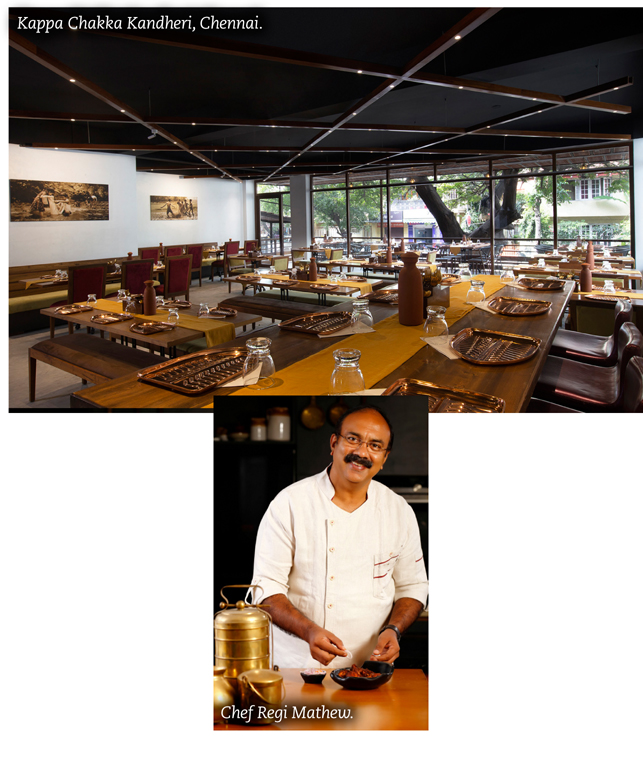 Kappa Chakka Kandhari, Chennai and Bengaluru
Kappa Chakka Kandhari, Chennai and Bengaluru
Founded by Chef Regi Mathew, a veteran of Taj hotels, along with partners John Paul and Augustine Kurian, the restaurant focuses on Kerala’s rich gastronomic heritage. “I wanted to revive undocumented recipes, particularly those from mothers’ kitchens, which lack formal documentation. Kappa Chakka Kandhari (KCK) is a tribute to the food I grew up eating— backyard ingredients like tapioca, jackfruit, and Kandhari chillies.”
Kerala’s toddy shops are among chef Regi’s favorite haunts. Their fresh, bold-flavored “touchings” (snacks served with toddy), inspired dishes like Koonthal Roast (dry-roasted calamari) and Kada Dry Roast (spiced quail), and are some of his favorite dishes.
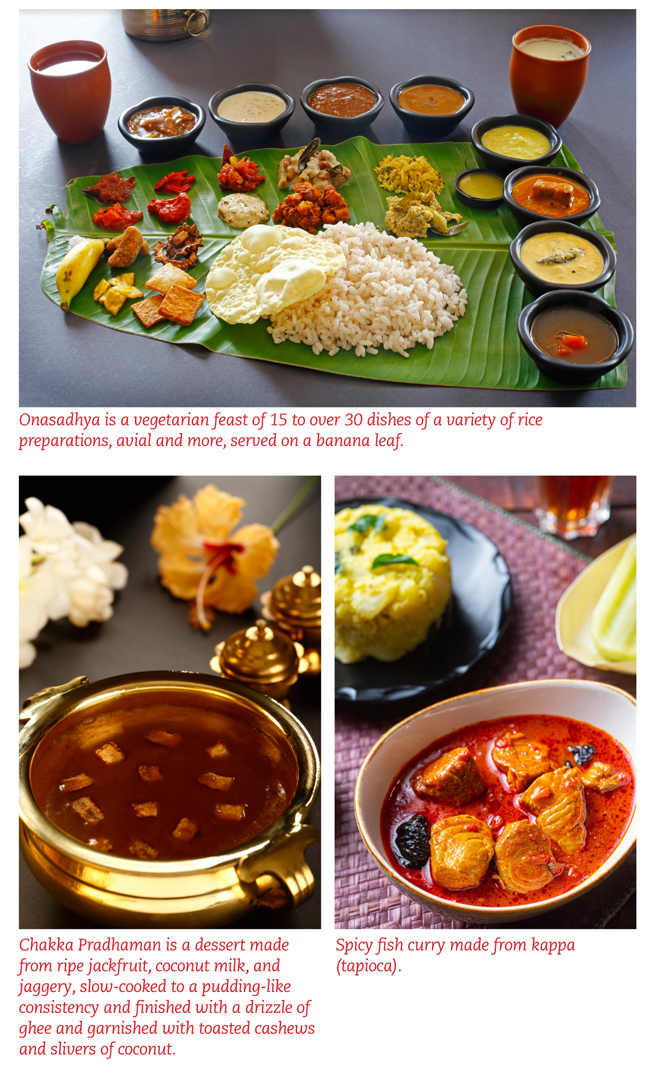 The distinguished name of the restaurant reflects three quintessential Kerala ingredients—kappa (tapioca), chakka (jackfruit), and Kandhari (bird’s eye) chilli—symbolizing the rustic, ingredient-driven cuisine of his childhood.
The distinguished name of the restaurant reflects three quintessential Kerala ingredients—kappa (tapioca), chakka (jackfruit), and Kandhari (bird’s eye) chilli—symbolizing the rustic, ingredient-driven cuisine of his childhood.
KCK was ranked first in 2023, and second in 2022, in Culinary Culture’s Top 30 Chefs in India, co-founded by food critic Vir Sanghvi; 23rd in Condé Nast Top Restaurant Awards 2019; and 22nd among India’s Top 50 Restaurants by Condé Nast Traveler.
Menu: Chef Mathew was inspired to move beyond the well-known Kerala dishes such as biryani and parotta. Among his signature dishes is Kappa Fish Curry, a traditional pairing of tapioca with rich, flavorful fish curry made with local fish like karimeen (pearl spot). The Nadan Kozhi Curry is a chicken curry made with authentic Keralan spices, paired with appam or idiyappam (string hoppers). Chef Mathew has introduced Kerala-inspired sushi, where conventional ingredients, such as coconut, seafood, and local spices, are creatively paired with sushi rolls, a Japanese twist to the region’s culinary traditions.
The menu at KCK is based on three pillars: well-loved Kerala classics like Kappa Fish Curry and Karimeen Pollichathu (pearl spot fish grilled in banana leaves); home kitchen specialties or recipes sourced from mothers and home cooks, such as Pazham Nanachathu and Pidi with Kozhi Curry (rice dumplings with chicken curry); and innovative dishes, such as Kandhari Ice Cream (sweet ice cream with a spicy bird’s eye chilli kick) and Pazham Pori with Pothirachi (banana fritters paired with tenderloin meat), blending nostalgia with modern flair.
Terrāi, Hyderabad
Founded by restaurateurs Rohit Kasuganti and his wife Anisha Deevakonda, Terrāi is the only restaurant in India dedicated exclusively to the cuisine of Telangana—the country’s newest state. “Our core objective,” says Kasuganti, “is to bring the deeply rooted culinary traditions of the state into a sharp spotlight. Every dish served at Terrāi stands as a vibrant tribute to the land, meticulously crafted with local ingredients sourced predominantly from women farmers and tribal chefs who employ time-honored techniques.”
Terrāi is inspired by Kasuganti’s grandmother’s cooking in their ancestral village of Yellapur in Uttara Kannada district. Dishes such as Pulusu (a tangy vegetable stew), moong fritters, Kudumulu (steamed rice dumplings), and smoky roasted corn harvested from his family’s farm inspired a vision to preserve and elevate Telangana’s food heritage. “After Telangana gained statehood in 2014, its cuisine began to emerge from Andhra Pradesh’s shadow. The food—characterized by millets, minimal spices, and unique ingredients like jaggery and peanuts—was underrepresented in Hyderabad’s dining scene, which was dominated by biryani and Nizami influences. This motivated us to showcase the state’s distinct food culture,” he explains.
Conceptualized by Sona Reddy Studio, the 12,000-square-feet restaurant blends modern and traditional aesthetics. A material palette of black granite and terracotta-toned walls evokes Telangana’s village homes. Ikat-inspired flooring and Dhokra metal art pay homage to the state’s textile and craft traditions.
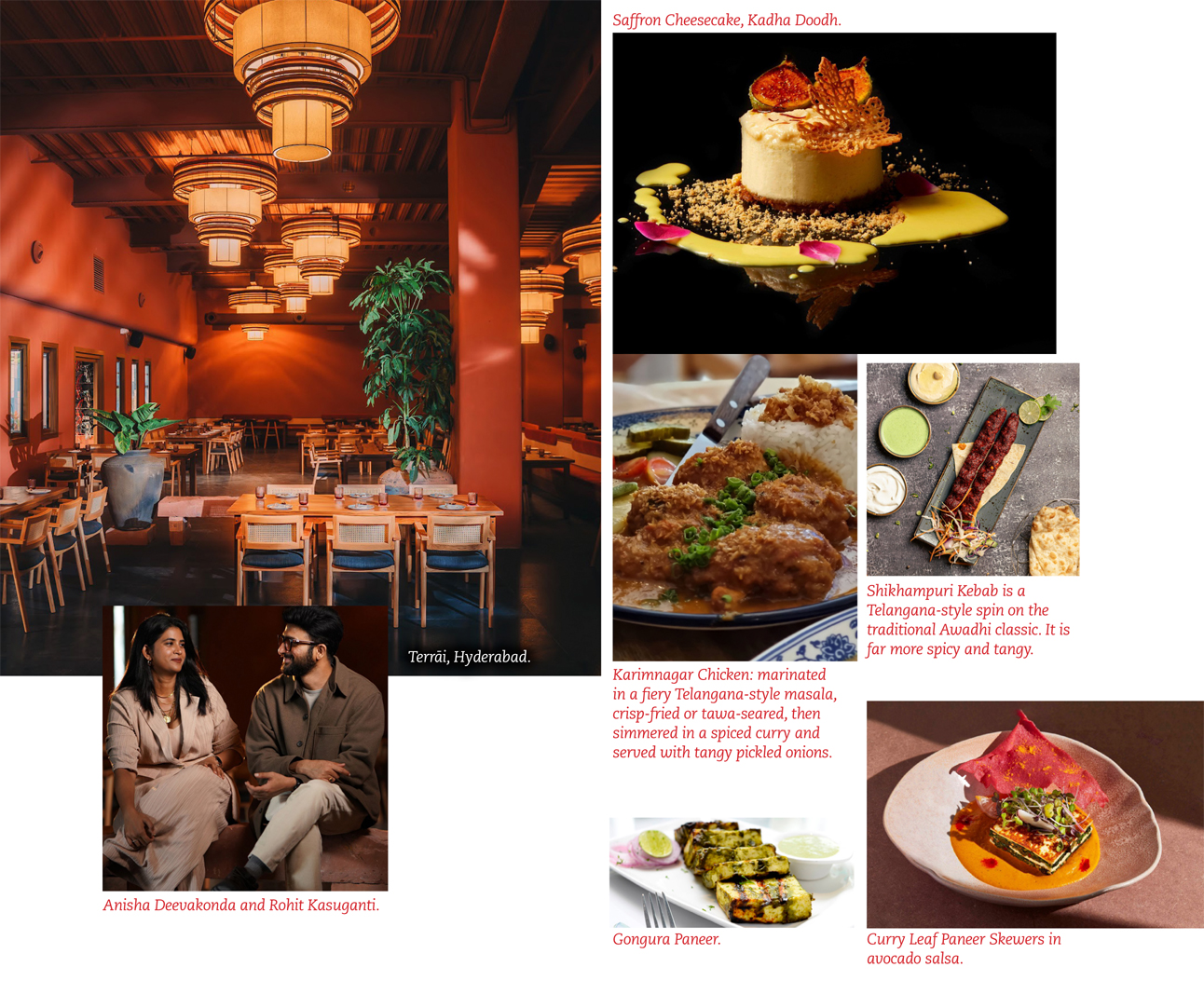
MENU: A nod to Telangana Spice Kitchen, a once-popular Hyderabad eatery, is evident in the Karimnagar Fried Chicken. Look closely at the menu for a photo of Fayaz, the original cook who created the dish and still works at Terrāi. Telangana’s ingredients and flavors find new expression in dishes like Gongura (sorrel leaf) Paneer Tikka, Fish Tikka with a punch of raw mango, and spicy Mutton Shikampuri Kebab—a favorite from Hyderabad’s old city—enhanced with a dill-yoghurt dip. The menu showcases the region’s agricultural staples, especially millets, which thrive in Telangana’s arid climate, in contrast to the rice-centric cuisine of erstwhile Andhra Pradesh.
“We have tried to bring home-cooked and tribal community dishes to a sophisticated fine-dining setting,” says Kasuganti. Contemporary techniques like sous vide and deconstruction is used to elevate traditional fare while preserving authentic flavors.
To ensure authenticity and sustainability, Terrāi collaborates with the Deccan Development Society (DDS), a 40-year-old farmers’ cooperative led by 5,000 indigenous women in Zaheerabad. “We source 90 percent of our indigenous ingredients—including uncultivated greens that grow symbiotically with millets— from DDS. This supports sustainable farming and biodiversity while empowering communities,” Kasuganti adds.
Deepali Nandwani is a Goa-based freelance journalist, a columnist on luxury with CNBC-TV18, and an aficionado of everything heritage.
Enjoyed reading Khabar magazine? Subscribe to Khabar and get a full digital copy of this Indian-American community magazine.
blog comments powered by Disqus










